 |
|
Cool entire cities?
When dangerously high temperatures start
to arrive,
let's cool those cities quickly and safely.
|
Cool an entire city? Maybe we can.
|
Beat the heat as we work to fix the issue.
|
Invite the world to get involved.
|
|
|
|
|
| 1 |
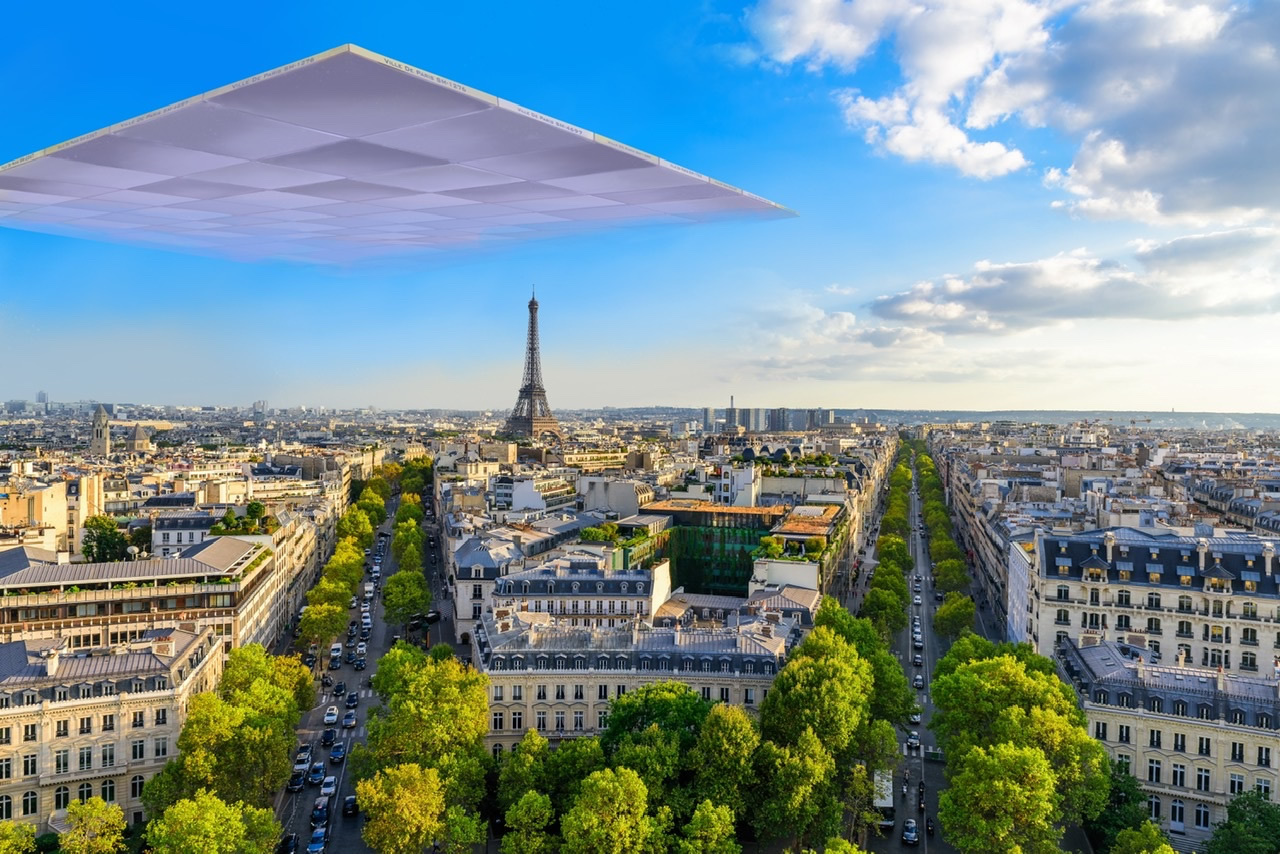
"Paris reflects.. and stays cool." • Vitaliia Kalmutska - Project Artist
Paris, July 7th, 2027. It's 7 AM.
Météo-France, the
meteorological service,
is forecasting
a record high
temperature of 50ºC / 122ºF.
63 SunMirrors are rolling in over the city.
By noon, 20,000 Sun Mirrors cover the sky,
reflecting heat back to space.
The promise is to lower
temperatures by 33ºC / 30 ºF
|
 |
|
The same SunMirrors that aim to moderate and shape a storm
crossing an ocean might also be deployed to mitigate 'Peak Heat Days' in sweltering cities all over the world. |
|
|
Won't all those SunMirrors floating over a metropolis make it dark?
Intentional gaps between areas of SunMirrors will allow for a greater area to be protected, and as well allow in modest amounts of sun.
The underside of every SunMirror is covered edge-to-edge with LED lights. They are super-efficient — and designed to radiate a sun-like color of light. Unlike sunlight, they will emit negligible amounts of heat. Their source of energy is the continuous sunlight that is falling upon the top surface of the SunMirror.
Most of the solar energy will be reflected back into the atmosphere and a good portion back to space — and a small amount will be used to provide near daylight to the City of Light.
Once excess CO2 levels were restored to pre-industrial levels, SunMirrors would no longer be required for heat mitigation of cities. However, there is no reason that they shouldn't still be utilized to mitigate the destructive potential of the larger and more dangerous hurricanes.
How do SunMirrors compare with seeding the sky with chaff?
Some proposals aim to lower temperatures planet-wide by utilizing high-flying special-purpose jet aircraft to distribute reflective chaff. Though noble in scope, effort and temporary benefit, reliance on continuously flying aircraft high in the atmosphere will themselves rely on fossil fuels, and thus a constant addition of more CO2 to an already polluted sky.
SunMirrors require no fossil fuels, and being unmanned, can stay aloft indefinitely. They also differ from the chaff model in that they are not designed to lower mean planetary temperatures, but to focus specifically on cities and populated areas that will need relief when temperatures would otherwise disrupt normal life, as well as exceed the temperature threshold required for human survival.

Image by Lisa Larsen from Pixabay • It's a lot cooler under the umbrella.
Concerns about Climate Change have a more venerable history than you might have imagined...
The first instance of scientific discussion concerning Climate Change occurred in the early 1900's! This is according to a New York Times article from 1956:
“According to a theory which was held half a century ago, variation in the atmosphere’s Carbon Dioxide can account for climatic change,” Waldemar Kaempffert wrote in The Times on Oct. 28, 1956. “The theory was generally dismissed as inadequate.”
NY TIMES
Way back in 1988, NASA scientist James Hansen famously brought before the US Congress the stark and growing danger to the world of the potential for climate disaster.
GRIST • NY TIMES
Cities in temperate zones — where they may be unable to adapt to the fierce heat of Peak Heat Days quickly — need solutions now.
SunMirrors could be the patch to the future, and be floating over cities as well as lessening the power of hurricanes in just a few years. |
SunMirrors might tamp down hurricanes, and they might provide some relief to great metropolises on their Peak Heat Days. No amount of reflective technology will matter, however, if we aren't dead serious about stopping CO2 pollution soon.
Lowering temperatures by shielding specific areas with airborne SunMirrors is not a solution to addressing Climate Change. However, it could very well be a bridge to the future, as we battle to slow CO2 and other greenhouse gas emissions, and ultimately stop them.
The concurrent step would be to remove greenhouse gases from the atmosphere. All of that will take decades. Therefore efforts to cool specific areas — such as cities — will buy us time. Without that 'bridge' to the future, there may be no way to survive the journey there.

Without a regimen of atmospheric CO2 removal over decades, eventually instabilities and unintended consequences will evolve even with scaled-up SunMirror technology compensating for some of the untoward effects of the ever-accelerating warming. Exacerbated by ever-increasing levels of CO2 from polluters, all technical efforts may be too little, and too late.
The disparity between temperatures for volumes of air beneath a SunMirror city heat remediation effort and the surrounding unprotected area will be extreme. Strong winds might occur — which might be welcome — but which also might dilute the effort.
People living and working just beyond the fleet might declare the unfairness of it. It might well be prudent to gradually reduce the density of individual SunMirrors at the periphery to create a gradual temperature border, rather than a stark one. However, the shade requirements of smaller municipalities will be much less than large cities, and all such areas might have smaller area SunMirror allocations provided.
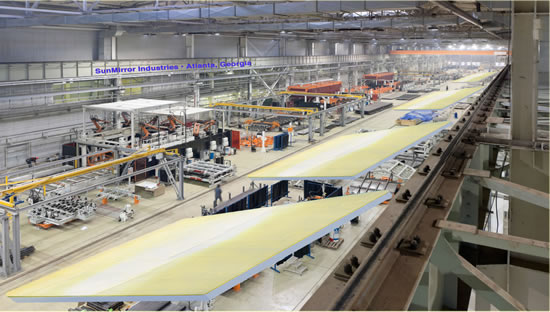
SunMirror Industries • Atlanta, Georgia, USA
Reflection offers only local solutions —
even though what is being contemplated here are very large scale reflectivity initiatives.
If we commit everything we've got to reducing greenhouse gas emissions, removing them from thin air will nonetheless take decades before the goal is successfully accomplished.
Without support, cities will be increasingly vulnerable — and more frequent and more powerful hurricanes will prevail.
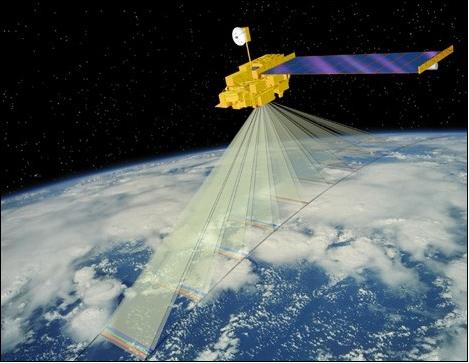
Courtesy NASA
"A sensor aboard NASA’s Terra satellite is now collecting detailed measurements of how much sunlight the earth’s surface reflects back up into the atmosphere. By quantifying precisely our planet’s albedo, the Moderate Resolution Imaging Spectroradiometer (MODIS) is helping scientists understand and predict how various surface features influence both short-term weather patterns as well as longer-term climate trends." NASA EARTH OBSERVATORY |
|
|
 |
Peak Heat Days are now more common — and more deadly.

istockphoto • For editorial use only. - Paris, France - August 19, 2012 • 97º Farenheit • 36º Celsius
People bathing in the fountains of the Trocadero, opposite the Eiffel Tower in Paris, in a heatwave.
Consider four related concepts regarding the Climate Emergency. |
|
|
• Temperatures in our day-to-day life are rising every year.
In general,
this year was hotter than last year. Next year will be hotter than this year. There is nothing preventing this trend, though there could be.
Adaptation and mitigation are today the main focus of Climate priorities. By positing vast scale CO2 removal strategies in addition to those two pillars of current thinking, we may accomplish more than we imagine. |
|
|
• Climate scientists recognize that the coming few years may contain more climate disruption than previously thought — though perhaps less than they may have projected for later years.
They indicate that with a doubling of CO2 in the atmosphere, our planet will warm between 4.7ºF and 7ºF / 2.6ºC and 3.9ºC. Those may sound like small increases in the heat index — though they are anything but. REVIEWS OF GEOPHYSICS |
|
|
• There is a palpable sense of despair and resignation among those who understand the calamity our civilization faces. Messaging that includes everyone is sorely needed to declare that we can actually reverse Global Warming if we are willing to get everyone on-board and do what it takes. |
|
|
• We can commit ourselves to the new reality — our entire civilization is in actual jeopardy. The future is grim. We face a catastrophe that will create unimaginable devastation for us.
It is a catastrophe of our own making.
We might consider that an effective response will entail implementation of the largest scale scientific and natural solutions ever conceived of and ever produced. Time is of the essence. |
|
|
Would SunMirrors protecting cities work?
|
 |
Let's have scientists and engineers weigh in on the matter. If there's an indication that SunMirrors might provide benefit, let's build a prototype, send it aloft, and extrapolate what a thousand or ten thousand might do.
If there's a sense that this technology might in fact have a beneficial part to play, then let's improve it, invest in it and field it.
If there's no positive result, we can say we did our best and put our focus elsewhere. We will learn useful data even if we fail. |
|
|
Greenland lost 2,000 gigatons of ice in the last ten years... and the melting continues.
Giving in
is not the answer.
Digging in will better serve the generations to come.
Ngozumba Glacier - Himalayas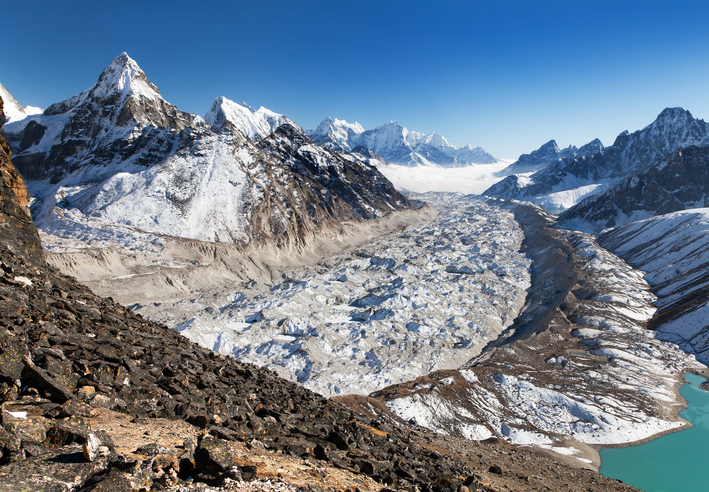
Kilimanjaro |
....from National Geographic
"Everywhere on Earth ice is changing. The famed snows of Kilimanjaro have melted more than 80 percent since 1912. Glaciers in the Garhwal Himalaya in India are retreating so fast that researchers believe that most central and eastern Himalayan glaciers could virtually disappear by 2035. Arctic sea ice has thinned significantly over the past half century, and its extent has declined by about 10 percent in the past 30 years.
NASA's repeated laser altimeter readings show the edges of Greenland's ice sheet shrinking. Spring freshwater ice breakup in the Northern Hemisphere now occurs nine days earlier than it did 150 years ago, and autumn freeze-up ten days later.
Thawing permafrost has caused the ground to subside more than 15 feet (4.6 meters) in parts of Alaska. From the Arctic to Peru, from Switzerland to the equatorial glaciers of Man Jaya in Indonesia, massive ice fields, monstrous glaciers, and sea ice are disappearing, fast.."
Read the full story here: NATIONAL GEOGRAPHIC |
|
|
|
Environmental Protection Agency • EPA • USA
|
|
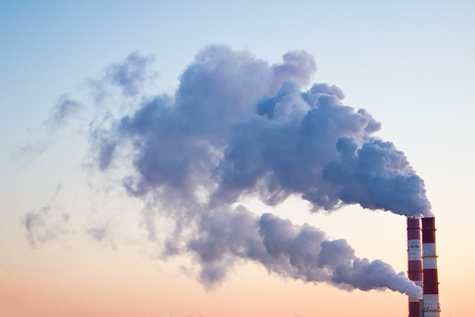 |
"Greenhouse gases trap heat and make the planet warmer. Human activities are responsible for almost all of the increase in greenhouse gases in the atmosphere in the last 150 years.
The largest source of greenhouse gas emissions from human activities in the United States is from burning fossil fuels for electricity, heat, and transportation." |
|
 |
Transportation - 29%
The transportation sector generates the largest share of greenhouse gas emissions.
Greenhouse gas emissions from transportation primarily come from burning fossil fuel for our cars, trucks, ships, trains, and planes.
Over 90 percent of the fuel used for transportation is petroleum based, which includes primarily gasoline and diesel. |
|
 |
Electricity - 25%
Electricity production generates the second largest share of greenhouse gas emissions.
Approximately 62 percent of our electricity comes from burning fossil fuels, mostly coal and natural gas. |
|
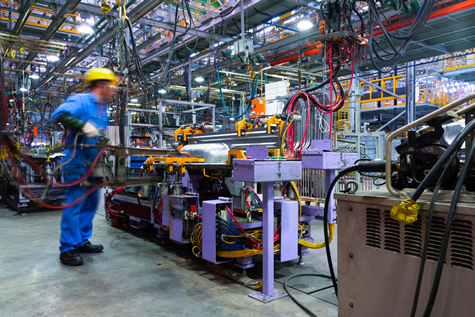 |
Industry - 23%
Greenhouse gas emissions from industry primarily come from burning fossil fuels for energy, as well as greenhouse gas emissions from certain chemical reactions necessary to produce goods from raw materials. |
|
 |
Commercial/Residential - 13%
Greenhouse gas emissions from businesses and homes arise primarily from fossil fuels burned for heat, the use of certain products that contain greenhouse gases, and the handling of waste. |
|
 |
Land Use & Forestry - 12%
Land areas can act as a sink (absorbing CO2 from the atmosphere) or a source of greenhouse gas emissions.
In the USA, since 1990, managed forests are a net sink, i.e., they have absorbed more CO2 from the atmosphere than they emit. |
|
 |
Agriculture - 10%
Greenhouse gas emissions from agriculture come from livestock such as cows, agricultural soils, and rice production. |
|
|
|
Emerging energy technologies will soon displace fossil fuels.
Electric and Hydrogen
The Pros and Cons
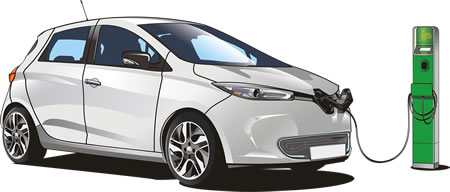
Image by Francis Ray from Pixabay • Electric car at a charging station.
Hydrogen fuel cells are ideal for automobiles- refueling is easy, and range is substantial. Hydrogen could be a guilt-free power source.
The current range for Hydrogen powered vehicles is between 320 to 380 miles per fill-up. The fly-in-the-ointment is the lack of stations that supply Hydrogen at present.
We tend to think the electricity for Electric Vehicles (EV's) is Carbon neutral and safe. Yet much of that electricity which powers electric vehicles in North America is derived from an electric grid that obtains 64% of its energy from fossil fuels and 19% from nuclear energy.
US ENERGY INFORMATION ADMINISTRATION
That will change to clean sun power over time, especially if laws are passed to demand it.
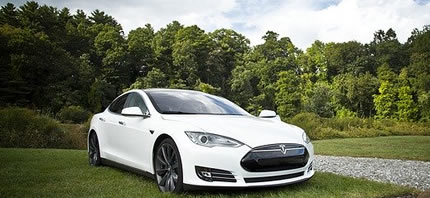
Tesla • Pixabay
EV's have the advantage of elegantly simple electric motors — which in theory should lower production costs compared with either fossil fuel powered or Hydrogen powered vehicles.
With increased competition and a groundswell of EV production by many other manufacturers, the cost for EVs is expected to become much more affordable for everyone. EVs require less maintenance than other cars, and they are generally much quieter.
EV's might soon have their skins covered with a new generation of solar cells which are 400 times more productive than current cells.
This bold new source of prodigious power for electric vehicles would largely obviate the need for charging stations. Even the full moon would generate electricity— though probably not enough to get you all that far.
All vehicles on the road can be tasked with CO2 removal, and that includes EV's and Hydrogen vehicles. It is not a punitive mandate; it's instead the recognition that overwhelming scale is the formula that will save the future, and all vehicles will be asked to do their part. |
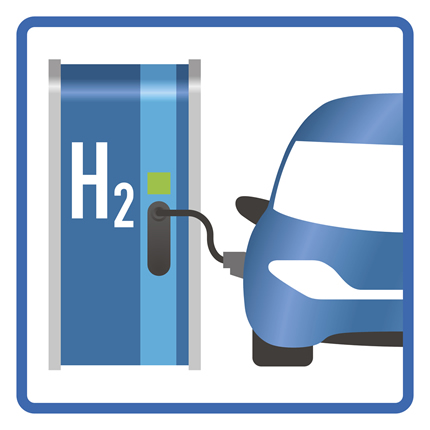
Hydrogen car being fuled.
Hydrogen fuel (H2) is much more expensive than gasoline, but that's expected to change as more motorists adopt the technology, and more Hydrogen stations are built.
New ways of safely storing H2 — with ongoing research being done right now — will lower costs, and substantially lower the weight of the secure tanks which contain it. That will permit more H2 to be in the vehicle's storage tanks, and thus greatly increase their range.
Read the 'Introduction': NATURE

istockphoto - Image portrayed is for journalistic usage in this document only.
Today H2 is produced by a process that relies on Methane. Environmental organizations oppose its practical implementation due to that issue. To assuage that concern, new legislation can insist that H2 production be solely from renewable solar and wind energy sources.
Gasoline is abundantly available, and electricity to power charging stations is being built out — but there is not as yet a loud public voice calling for the installation of Hydrogen fuel at service stations — except in California.
California is unapologetically supportive of Hydrogen fuel cell technology. "Hydrogen fuel cell electric vehicles are critical to the state’s goal of getting 1.5 million zero-emission vehicles on California roads by 2025. They are also a vital part of the state’s work to achieve its climate change goals, improve air quality, and reduce reliance on fossil fuels."
ENERGY CALIFORNIA |
|
|
|
| Consider buying a fully electric or Hydrogen powered automobile the next time you're in the market. Along with millions of your neighbors the world over doing the same, it will make a real difference. |
|
 Washington, D.C. • Climate March • 2017 • "CARE FOR ALL CREATION."
Washington, D.C. • Climate March • 2017 • "CARE FOR ALL CREATION."
|
|
|
|
 |